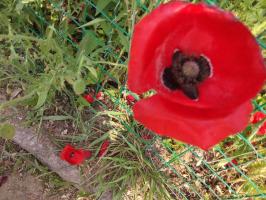Canola Plant: Appearance and Characteristics
Canola is a type of rapeseed oil plant that is widely grown for its oil-rich seeds which are extracted and refined to produce canola oil. The scientific name for canola is Brassica napus, and it belongs to the Brassicaceae family, along with mustard, broccoli, and cabbage. In this article, we鈥檒l take a closer look at what a canola plant looks like, its characteristics, and growing requirements.
Appearance of Canola Plant
A fully-grown canola plant typically reaches a height of about 1-2 meters, depending on the variety and growing conditions. It has a sturdy stem, with branching leaves and yellow flowers that bloom during spring. The flowers can be either self-pollinating or cross-pollinated by insects such as bees, butterflies, and moths. After the flowers are pollinated, they wilt and give way to clusters of small green pods that contain the canola seeds.
The leaves of the canola plant are dark green, smooth and shiny on the upper surface, and slightly hairy on the underside. They have a lance-like shape and are arranged alternately on the stem, with a serrated margin. The stem of the plant is thick and has a reddish or purple color at the base, while the upper part is green and smooth. The roots of the canola plant are shallow and fibrous, and they grow in a vertical pattern, which makes them ideal for absorbing nutrients and moisture from the soil.
Characteristics of Canola Plant
Canola is a very hardy and adaptable plant that can thrive in a wide range of soil types and climate conditions. It is tolerant to drought, frost, heat, and pests, making it an ideal crop for farmers in temperate regions. The plant requires full sun exposure and well-drained soil, with a pH level of 5.5-8.5, and moderate to high fertility. It can grow in areas with annual rainfall ranging from 300-900 mm, and the best planting time is during the spring or fall.
The canola plant belongs to the Brassica genus, which means that it has a pungent smell and taste due to the presence of glucosinolates, a type of compound that also gives its relatives like mustard, broccoli, and cabbage their distinct flavors. However, unlike its wild ancestors, canola has been selectively bred to reduce its glucosinolate content and improve its oil quality, making it a popular oil crop worldwide.
Cultivation and Harvesting of Canola Plant
To cultivate canola, farmers usually prepare the soil by plowing, harrowing, and leveling it to create a firm seedbed. They then apply fertilizers, herbicides, and pesticides to control weeds and pests that may interfere with the growth of the canola plants. The seeds are sown at a depth of 1-2 cm and spaced about 20-25 cm apart, either by broadcasting or using a drill. After planting, the seeds are covered with soil and watered regularly to promote their germination.
The canola plant usually takes about 3-4 months to mature, depending on the variety and weather conditions. During this time, farmers monitor the plants for any signs of disease or pest infestations and apply appropriate measures to prevent or control them. When the pods mature and turn brown, which usually happens during mid-summer, the plants are ready for harvesting.
Harvesting canola involves either direct harvesting or swathing. Direct harvesting involves using a combine to cut the plants and separate the seeds from the pods, while swathing involves cutting the plants and leaving them in the field to dry for a few days before threshing them to remove the seeds. After harvesting, the seeds are transported to a processing plant where they are cleaned, dehulled, and pressed to extract their oil.
Conclusion
In conclusion, the canola plant is a tall, yellow-flowered plant that is grown for its oil-rich seeds. It has a sturdy stem, branching leaves, and shallow fibrous roots that make it adaptable to a wide range of growing conditions. Canola requires well-drained soil, full sun exposure, and moderate to high fertility to thrive, and it is tolerant to drought, frost, heat, and pests. Cultivating canola involves preparing the soil, sowing the seeds, monitoring the plants for any signs of disease or pest infestations, and harvesting the mature pods. Overall, canola is an important crop that provides a valuable source of oil for cooking and industrial purposes.

 how many times do yo...
how many times do yo... how many planted tre...
how many planted tre... how many pine trees ...
how many pine trees ... how many pecan trees...
how many pecan trees... how many plants comp...
how many plants comp... how many plants can ...
how many plants can ... how many plants and ...
how many plants and ... how many pepper plan...
how many pepper plan...































